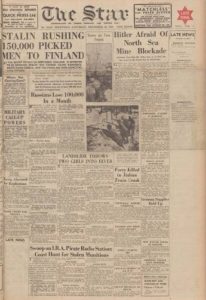These are troubled times for printed newspapers, all of whom are haemorrhaging circulation in the face of competition from the internet, and social media in particular. Many are in their death throes.
For somebody who spent his entire working life in journalism, the figures make depressing reading. When I started work on the Yorkshire Evening News in 1961 it was (unbelievably by today’s standards) selling 119,000 copies a day across its Leeds and Doncaster editions, and yet by the end of 1963 it had gone to the wall, regarded as uneconomic and absorbed by the rival Evening Post.
Today, regional evening newspaper editors can only dream of a circulation anywhere near that figure. In Sheffield, The Star, despite having the field to itself as far as South Yorkshire is concerned, is struggling along on a print circulation of less than 12,000 copies a day.

Nancy Fielder is editor of JPI Media’s stable of daily and weekly newspapers based in Sheffield, including The Star and weekly Sheffield Telegraph, and she had already filled us in on the state of play in the newspaper industry generally when she last visited Stumperlowe Probus Club in July 2018. Since then, things have only got worse.
Nancy’s latest presentation, timed to perfection just three days before a General Election, was more about the part played by newspapers and the internet, including their own online offerings and social media platforms such as Facebook and Twitter, in influencing public opinion.

Johnston Press plc, the country’s biggest regional newspaper publisher and the Sheffield titles’ previous owner with a market capitalisation of just £3 million, placed itself in administration in November 2018 when it was unable to find a suitable buyer of the business to refinance its £220 million of debt. Its assets were brought under the control of JPI Media Ltd, a company formed by a consortium of Johnston Press’s main creditors who reduced its debts to £85 million and injected £35 million of investment.
“The reality is that fewer people are buying the print product, and that is where most of the money comes from, but more people are accessing our website,” explained Nancy, fresh from her appearance discussing the weekend papers on BBC Breakfast.
Generating enough money from the website to make up the loss of income from the printed paper is easier said than done. Advertising revenue goes some way towards this, but the business model is complicated and the long-term viability of the website is far from certain despite, or perhaps because of, the ease with which people can click on www.thestar.co.uk by following a link from, say, Facebook.
“More than half of all the ‘hits’ we get online come via Facebook,” Nancy told us. So that must mean that Facebook is doing The Star a big favour by driving traffic to their website. Well, yes and no. Obviously, the more people who visit the website the more The Star can charge advertisers for the privilege, but only to a certain point. Because who are The Star competing with for advertising revenue? You’ve guessed it – Facebook.
“Companies such as Google and Facebook can undercut us for advertising because they are so big but, although we are having to compete with them [for income from advertising] it is our news that people are clicking on. And we have a shrinking number of reporters with an ever bigger job to do.”
So, while there is no doubt that newspaper websites such as The Star’s are attracting a healthy amount of traffic, just how sustainable they will be in the long term from a commercial point of view is still largely an unknown.
In September, in the face of squeezed advertising revenues, The Star took a significant step in securing the viability of its website by introducing a so-called paywall. This allows readers to view five free articles a week, after which they will have to register and choose from a range of subscription plans such as £1 per month for three months and £2 per week thereafter, or £52 for the first full year and £78 per year thereafter.
One interesting difference between printed newspapers and a website is that content can be better tailored to meet readers’ tastes.
As Nancy explained: “With the front page [of the newspaper] it was always a bit of a gut reaction, what we thought people would like, but now we can actually see what people are looking at.
“But it is doubtful that the election will be the most read item.”
To illustrate her point, Nancy brought along a screen shot of the electronic ‘scoreboard’ which is permanently on display in The Star’s newsroom and shows, in real time and updated almost by the second, what visitors to the website are looking at.
On the morning of her visit, the most read item up to eight o’clock had been Sheffield United’s comeback against Norwich City. The first political story on the list, about LibDem leader Jo Swinson’s visit to Sheffield, ranked only sixth.
“If they are not looking at politics today, when will they be?” she asked. “We know what interests the people out there. If they are not clicking on politics, why should we write about politics?
“It is a very worrying trend, and a depressing picture that they [the figures] paint.

On a recent day, in the middle of the General Election campaign, the most viewed stories were about a Sheffield customer who was turned away from a pub for wearing a flat cap, which attracted 51,000 hits, and an item about a Sheffield mother who complained that her son’s day – “if not his life” – had been ruined by a Cadbury’s advent calendar which was missing its chocolates, and which attracted 47,000 views.
“You get more money, the greater number of people looking at your website, so you have to give them what they want to read,” Nancy added.
“It’s quite a serious debate, how to get people to engage with politics. We’ve had stories about national politicians coming to the city, which we have put on the front page of the printed paper, but virtually nobody was looking at them on the website.”

Nancy also believes that local democracy is at risk because papers such as The Star, which will only publish unbiased stories, are often competing with political leaflets which are made to look like local newspapers. “Political parties put a tremendous amount of effort and money into producing material which just isn’t true,” she claimed.
The Star was first published in 1887. Let’s hope it’s got a few more years’ life left in it.
